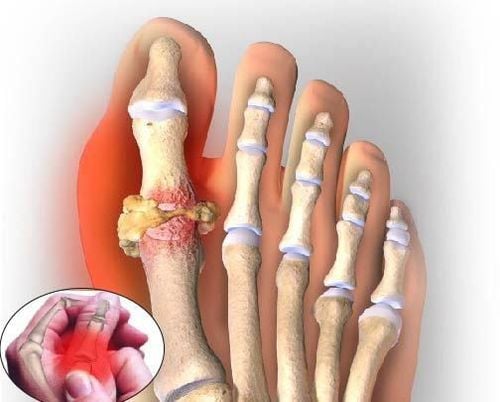This is an automatically translated article.
Article by Master, Doctor Mai Vien Phuong - Gastrointestinal endoscopist - Department of Medical Examination & Internal Medicine - Vinmec Central Park International General Hospital.
Chronic pain syndrome can change the way nerve cells work, making them oversensitive to pain messages. Because certain conditions can lead to chronic pain syndrome, Your doctor may order imaging tests to determine if there is damage to your joints or tissues in your body.
1. What is chronic pain syndrome?
Most pain goes away after an injury heals or an illness progresses. But with chronic pain syndrome, the pain can linger for months, years after the body heals, even when there's no known cause.
According to the National Center for Complementary Health of America, chronic pain is defined as lasting 3 to 6 months and it affects approximately 25 million Americans.
2. Symptoms of Chronic Pain Syndrome Chronic pain syndrome affects your physical and mental health. Symptoms include:
Joint and muscle pain Burning pain Fatigue Affecting sleep Loss of stamina and flexibility due to decreased activity Mood problems, including depression, anxiety and irritability 3 Causes of Chronic Pain Syndrome Osteoarthritis: This type of arthritis is generally the result of wear and tear on the body and occurs when the protective layer of cartilage between bones wears away. Rheumatoid arthritis: This is an autoimmune disease that causes painful inflammation in the joints. Back pain: This pain can stem from muscle strain, nerve compression, or arthritis of the spine (called spinal stenosis). Fibromyalgia: This is a neurological condition that causes chronic pain syndrome in different parts of the body (known as trigger points). Inflammatory bowel disease: This condition causes chronic inflammation of the digestive tract and can cause intestinal pain and cramping. Surgical trauma. End-stage cancer . Even when these conditions improve (through medication or therapy), some people may still experience chronic pain. This type of pain is generally caused by faulty communication between the brain and the nervous system. For unexplained reasons, some people may experience this type of pain without any known triggers.
Chronic pain syndrome can change the way nerve cells (neurons in the brain that transmit and process sensory input) work, causing them to become oversensitive to pain messages. For example, according to the Arthritis Foundation, 20% of people with osteoarthritis who receive a knee replacement (and presumably no longer have painful joint problems) will still have chronic pain.

People with chronic and painful conditions, such as arthritis. Depression and anxiety: Experts aren't sure exactly why, but one theory is that depression changes the way the brain receives and interprets messages from the nervous system. Smokers: There's still no definitive answer, but experts are learning why smoking seems to make pain worse in people with arthritis, fibromyalgia, and other conditions. other chronic pain disorders. Obese people: According to research, 50% of people who seek treatment for obesity report mild to severe pain. Experts aren't sure if this is due to the stress that weight adds to the body or to the complicated way obesity intertwines with hormones and the body's metabolism. Those who are female: Women tend to be more sensitive to pain. The researchers theorized it could be due to hormones or the difference in nerve fiber density of females and males. People over 65: As you get older, you're more susceptible to all sorts of illnesses that can cause chronic pain. 5. How is chronic pain syndrome diagnosed? The first thing your doctor will do is take a thorough medical history. You will be asked things like:
When did your pain start? How it feels (eg, burning and stinging or dull and aching) Where the pain is Because certain conditions can lead to chronic pain syndrome, your doctor may order imaging tests to determine if there is joint or tissue damage to explain your pain. For example, your doctor may order an MRI to determine if your pain is stemming from a herniated disc, an X-ray to detect osteoarthritis, or a blood test to check for rheumatoid arthritis. short.
6. Chronic pain syndrome treatment Chronic pain can make you tired, worsening quality of life. However, chronic pain syndrome is treatable. Chronic pain treatments include:
6.1. Medical treatment Pain relievers: These can be anti-inflammatory drugs, steroids, muscle relaxants, antidepressants that also work to relieve pain and, in severe cases, opiates (this is a last resort) . Physical therapy to increase flexibility and range of motion. Nerve blocks to interrupt pain signals. Psychotherapy/behavior: While they may not have a big effect on pain, some psychotherapies can have a positive effect on mood. For example, cognitive behavioral therapy (a type of talk therapy that helps you control negative thinking) has been shown to be effective in boosting mood, even up to a year after treatment. end. In another study, biofeedback was beneficial in reducing muscle tension, depression, and improving the ability to cope with chronic pain. Biofeedback is a type of therapy that teaches you to use your mind to control your body's responses, such as rapid breathing. 6.2. Alternatives to Acupuncture: According to an analysis of studies, acupuncture reduced pain levels in 50% of those who tried it, compared with a 30% reduction in pain in those who did not. Hypnosis: Research reported that 71% of subjects with irritable bowel syndrome (IBS) reported significant improvement in symptoms after a hypnosis course. These effects persisted for up to five years after treatment. Yoga: Because it relaxes muscles, encourages deep breathing, recovery, and increases mindfulness, research shows that yoga can be beneficial in reducing the depression and anxiety that accompanies chronic pain, due to That improves your quality of life. When you're not feeling well, managing chronic pain can be difficult. Emotional stress can make the pain even worse. Therefore, to limit and prevent chronic pain, you should participate in activities that seek both psychological and physical help.
The above information is for reference only. You should consult your doctor before deciding on any treatment.
Please dial HOTLINE for more information or register for an appointment HERE. Download MyVinmec app to make appointments faster and to manage your bookings easily.
References:Gonsalkorale WM, et al. (2003). Long term benefits of hypnotherapy for irritable bowel syndrome. gut.bmj.com/content/52/11/1623.full Janke EA, et al. (2007). Overview of the relationship between pain and obesity: What do we know? Where do we go next? ncbi.nlm.nih.gov/pubmed/17551876 Rayner L, et al. (2016). Depression in patients with chronic pain attending a specialised pain treatment center: Prevalence and impact on health care costs. DOI: 10.1097/j.pain.0000000000000542 Sielski R, et al. (2017). Efficacy of biofeedback in chronic back pain: A meta-analysis. link.springer.com/article/10.1007/s12529-016-9572-9














